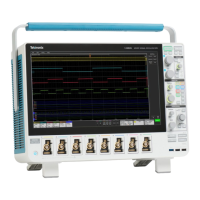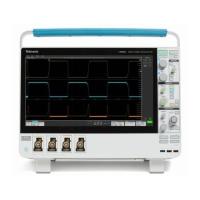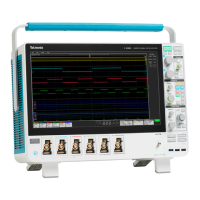11. Click the Lock and Scroll tab to select a zoom lock and scroll setting:
■
To scroll a single zoomed area, click Zoom <1–4>, and then click an AutoScroll button.
■
To scroll multiple zoomed areas simultaneously, click Lock, and then click the Zoom <1–4> buttons you want to scroll
through.
12. To quickly determine the magnification factor and position of a zoomed waveform, check the controls on the appropriate tab
(Horizontal or Vertical) of the Zoom Setup control window.
13. To reset all Zoom settings to their defaults, click the Position Factor Reset button in the Zoom Setup control window.
Choosing a color palette
Choose a color palette
Use the following information to help you select a color palette:
1. Select Colors In the Display menu, or click Display in the toolbar.
2. Open the Colors tab.
3. Under Record View Palettes or FastAcq/WfmDB Palettes, click a button to select a palette for your application. Use the
following criteria:
■
Normal. Use this palette to display hues and lightness levels for best overall viewing. Every waveform has its own
color: shades of yellow for channel one; shades of blue for channel two, shades of pink for channel three, shades of
green for channel four.
■
Green. Use this palette to display waveforms and the graticule style in shades of green. The Green palette simulates
the display of an analog oscilloscope. Areas of the waveform with the highest sample density appear in lighter shades
while the areas of lower sample density appear in darker shades.
■
Gray. Use this palette to display waveforms and the graticule in shades of gray. Areas of the waveform with the highest
sample density appear in lighter gray shades, while areas of the waveform with lower sample density appear in darker
gray shades.
■
Temp. Use this (temperature) palette to display variable persistence style waveforms. Areas of the waveform with the
highest sample density appear in warmer colors (red shades), while areas of the waveform with lower sample density
appear in cooler colors (blue shades). This palette is best suited for seeing detail within a single waveform.
■
Spectral. Use this palette to display variable persistence style waveforms. Areas of the waveform with the highest
sample density appear in blue shades, while areas of the waveform with lower sample density appear in red shades.
This palette is best suited for seeing detail within a single waveform.
■
User. Use this palette to select a color previously defined for the User palette.
NOTE. To define a custom color for the User palette, click the Edit button and follow the steps to Customize Color Palettes.
Customize the display palette
From the Display menu, select User Palette, or click the Edit button in the Colors tab of the Display control window.
How to ?
642 DPO70000SX, MSO/DPO70000DX, MSO/DPO70000C, DPO7000C, and MSO/DPO5000B Series

